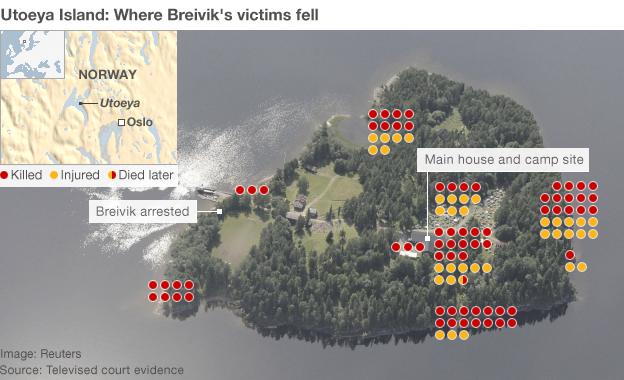Breivik trial: Utoeya survivor heard 'worst screaming'
- Published
The BBC's Lars Bevanger says a man set himself alight outside the courthouse earlier
A teenager who survived Anders Breivik's Utoeya massacre has told his trial she heard "the worst screaming" as he carried out his attacks.
Marta-Johanne Svendsen, who was shot in the arm, described hiding with others in a building and hearing twigs snap as Breivik tried to get in.
As proceedings continued, a man set himself on fire outside the courthouse.
He tried to enter the Oslo building but was stopped by police and taken to hospital to be treated for burns.
Our correspondent in Oslo says the man was shouting something as he ran towards the entrance of the courthouse, but police say it was not about Breivik.
They do not yet know what his motive was. He is being treated for serious burns to the head and chest.
Barricades
Earlier the court heard from Ms Svendsen, 17, who had adjusted her chair away from Breivik as she began her testimony.
She told how after she had been shot in the arm she ran through a field of tents. "It was perhaps the worst screaming I've ever heard" she told the court.
She described removing her jacket and seeing a hole in her arm. A first aider then led her into a building known as the school house, she said.
Ms Svendsen spoke of how Breivik suddenly grabbed the door handle and how she was convinced he would kill them all. People later hid under beds as Breivik shot at them through the windows, she told the court.
Another witness, first aider Even Andre Kleppen, told how he brought a group of people to the school house to shelter.
They barricaded the windows and doors. He then watched through the glass in the front door as Breivik calmly walked towards it and tried to shoot his way in, he said.
All 47 people who hid in the school house survived.
Firecrackers
The Oslo court also heard from survivor Ina Rangoenes Libak, who was shot four times.
She told the court that when she first heard the shots, she thought they were firecrackers.
When she realised what was happening, she and two others hid behind a piano in the cafe she was working in.
When shot in the arms she explained that she thought she could survive; when hit in the jaw she thought that was more serious; when realising she had been shot in the chest, she told the court: "That you die from."
Showing the court a scar on her arm, she explained that she lost feeling in both her arms when she was hit.
She ran away down a corridor, and told the court she was thinking: "this is what it's like to die, I'm dying."
Outside the building, she and others tried to use rocks to stem the bleeding. While they helped each other, they heard more shots, screams and then silence.
A friend said "they're dying, they're dying, we must help them", she told the court.
'Very calm, very pale'
Another witness told the court in tears how his friend drowned as Breivik fired on them as they swam for their lives.
The survivor, who wished to remain anonymous, said his friend was weak, having recently suffered an infection, and that it became clear he would not be able to make it.
In court, Anders Breivik watched impassively as the witness wiped away tears and struggled to describe events in the water.
"I put my ears underwater so not to hear [shots] and heard shots hit the sea floor", the witness said.
Breivik appeared "very, very calm and also very pale", he told the court. He had believed at first that he was police, because he appeared to have authority.
Anders Behring Breivik was apprehended by special police on the island. He admits the 69 killings on Utoeya, and eight more in a bomb attack in Oslo on 22 July 2011.
The trial's outcome hinges on whether the court finds Breivik to have been sane or not, as it could determine whether he is sent to prison or to a psychiatric institution.
